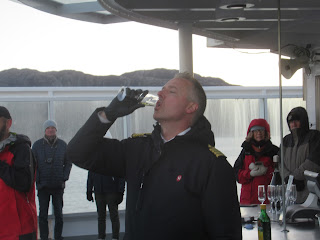Salmon Farming in Norway
And yet more shipping, a rig support vessel and a coaster.
And then it was an escape from the Arctic as we passed the globe on the island that marked the Arctic Circle.
A close up of the globe.
And of course there was another ceremony, not ice down your back but this time a case of cod liver oil, being held up by Sigmund, the Hotel Manager.
A close up of the bottle. Explorers found this particularly useful in ensuring that they had the right vitamins when exploring in the cold, dark Arctic.
Raymond the captain drank his out of a glass. Rune, the lead in the Coastal Experience Team said that the captain was 94 years old but that the daily dose of cod liver oil made him look young.
A boat cuts through our wash as we dock at Sandnessjøen. We set off again and were soon passing the Seven Sisters...

There were two troll kings who didn't agree on much except that their children needed more discipline. Th northern king had a wayward son who chased women trolls called the Horseman. The southern king had seven daughters who he sent to a maiden troll to teach them how to be good lady trolls. They were swimming when the Horseman saw them and fell in love. He started to chase them but realised that they were faster than he was.
He thought that if he couldn't have his love, then no one would. He raised his bow and fired an arrow but another troll witnessed the scene and threw his hat in the way of the arrow. The arrow pierced the hat and fell to the ground. But with all this action, they hadn't kept a note of the time and it was sunrise and all the trolls turned to stone. The Seven Sistera turned to stone just south of Sandnessjøen, The chasing troll became the Horseman Mountain near the island with the globe on it marking the arctic Circle and the hat became Torghatten Mountain with a curious hole in it. which people who don't believe in trolls think is just a cave through the mountain, but the troll story is much better at describing the creation of these features.
The Seven Sisters from further along the coast.
The tallest structure in Brønnøysund, the bridge connecting several small islands to the mainland.We crossed the bridge to reach the salmon fish farm. The cages on the right were empty.
The control centre, floating on the end of the floating pier.
One of the cages, circumference of 60 metres and 19 metres deep. It originally had 5,000 fish but they are going to the slaughter house and only 500 are left. And since they are fewer, the netting has been pulled up and hung on hooks to reduce the depth of the cage. Commercial farms have cages with a circumference of 180 metres up to 60 metres deep holding 200,000 fish.
Some of the netting that has been pulled up bulging from the hooks around the inside of the top of the cage.
The silo holding the food pellets which are moved by air pressure ti the central feeding hub in each cage. There is no feeding hub in the above cage as they are about to go to slaughter and their stomachs must be empty.
This is a central post that would hold the central feeder (removed for maintenance) and it usually sits in the middle of the cage and when the fish are small, there are nets that street from the sides of the cage and over this centre mounting to keep the birds away. Once the fish are large enough, they are too big for the birds to catch so the bird netting can be removed.
aside the floating control room with a fish on the table ready to be filleted.
A blurry photo of a scoop of food pellets, made from soya, seaweed, fish flour and aspartame. Salmon naturally is a white meat but if it consumes enough shrimps, its meat turns salmon pink. The taste is the same but the buying public expect pink salmon, hence the need for additional natural colouring.
...the fillet...
...and to check for colour.
The fish farm is part of a private higher education establishment that teaches aquaculture.
Torghatten, the hat that saved one of the Seven Sisters from the arrow...
...the hole in the hat that the arrow made...
...another view...


































No comments:
Post a Comment